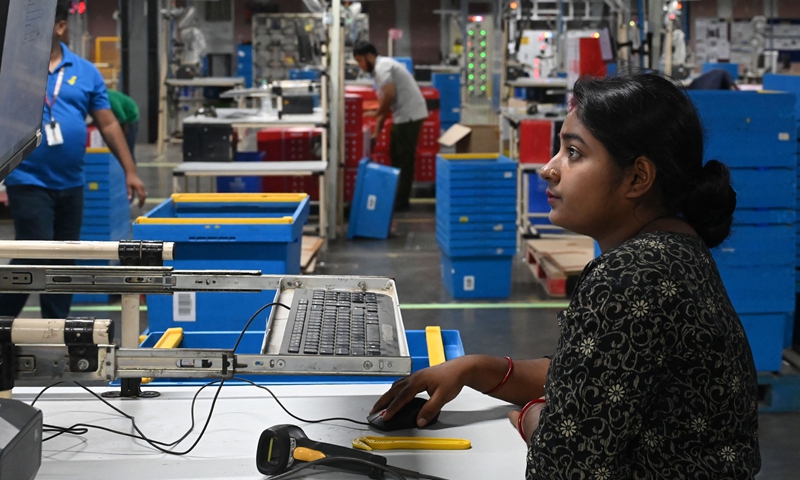
Employees work at a company at Haringhata, India on August 3, 2023.Photo: VCG
US Vice President JD Vance will embark on a four-day visit to India on Monday as the two countries seek to unlock economic opportunities and negotiate a bilateral trade deal, the Associated Press (AP) reported. However, the trip is unlikely to ease India's concerns over the US "reciprocal" tariffs or secure any significant shift in India's trade policy, analysts said.
Vance will be joined by his wife Usha Vance - a practicing Hindu - along with their children and senior members of the US administration, AP reported. The itinerary includes visits to Delhi, Jaipur and Agra, according to the Indian Ministry of External Affairs.
According to the scheduled agenda, Indian Prime Minister Narendra Modi will host Vance for talks and a dinner on Monday evening, reported the Times of India. Talks are expected to focus on finalizing the proposed India-US bilateral trade agreement and exploring ways to strengthen overall ties between the two countries. Vance will be accompanied by at least five senior US officials, including representatives from the Pentagon and the State Department, said the report.
This is Vance's first official trip to India, AP reported.
Chinese analysts view Vance' visit, a blend of official diplomacy and family engagement, as an attempt by the US to solidify trade relations with India at a time of heightened tariff-driven tensions with its major trade partners. But they noted the visit is unlikely to relieve the South Asian country from the currently paused "reciprocal" tariffs.
Qian Feng, director of the research department at the National Strategy Institute at Tsinghua University, told the Global Times that Vance may be pursuing multiple goals, from promoting a long-discussed bilateral trade agreement to seeking alignment on tariff issues. But he may find it difficult to achieve any significant results, especially given the US' domestic demand to reduce trade deficits and bring manufacturing back to the US, which runs counter to India's own "Make in India" initiative.
Despite prior progress, including a March 29 agreement between the US Trade Representative and India's Department of Commerce to expand bilateral trade to $500 billion by 2030, major hurdles remain. According to AP, US had targeted India with a 26 percent levy as part of the US now-paused tariff program.
Experts noted that amid the ongoing US' tariff war, Vance is expected to use the trip to reassure India on tariff-related matters and project a willingness to negotiate. However, India may be reluctant to make trade concessions with the US that jeopardize its "Make in India" strategy. India is also likely to remain cautious about whether the US will follow through on any tariff commitments, Qian noted.
Divergences between the US and India on tariffs and trade stem largely from differing economic interests and strategic priorities, Wang Peng, an associate research fellow at the Beijing Academy of Social Sciences, told the Global Times on Sunday.
While the US seeks to use tariffs as leverage to push India toward trade concessions, India is focused on safeguarding its own trade interests and advancing a fairer trade environment. Given India's ongoing efforts to bolster its domestic manufacturing sector, the two sides are unlikely to find common ground easily, Wang said.
With steep tariffs making Chinese imports less affordable for US consumers, Vance may look to India as an alternative source of goods. However, India's supply chain capacity still falls short of China's, making it difficult to meet US expectations. Moreover, increasing imports from India would contradict the original US aim of cutting trade deficits and reshoring manufacturing, making Vance's strategy internally inconsistent, Wang said.
Vance's visit to India could also include Washington's intention to deepen strategic cooperation with New Delhi, Qian said.
However, Qian cautioned that India should remain clear-eyed about the current "America First" prioritization in the US. Rather than fully aligning with US interests, India would benefit more from pursuing a balanced approach, including engaging with the US on its own terms while strengthening solidarity with global powers that genuinely support fair and open trade, Qian noted.




